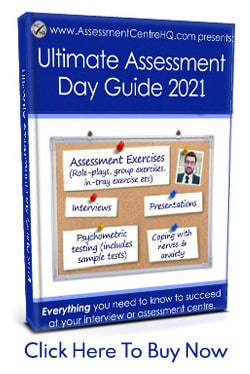How To Pass Your E-Tray Exercise (Includes Practice Test Exercise)
This free E-tray exercise success guide will tell you what to expect during your E-tray exercise and show you how to succeed.
Note that the E-tray exercise is very similar to the ‘in-tray exercise’. The E-tray exercise is an electronic version of the in-tray exercise (which is usually paper-based). The principles for success are identical for both exercises.
What’s in This Guide?
- 3 essential E-tray resources to boost your chances of success
- 1 E-tray exercise example (and links to more)
- The 3 Simple Steps to E-Tray Exercise Success
2 Essential Resources for E-tray Exercise Success
- You can try a real E-tray exercise here.
- You can listen to the ACHQ podcast episode covering ‘E-tray success’ here.
Download our Ultimate Assessment Day & Interview Guide 2022 here. (It's packed with tips, tricks and insider-secrets to help you succeed.)
Ok, let’s learn how to pass your E-tray exercise!‘What Is the E-tray Exercise?’
The e-tray exercise is an assessment activity that’s widely used by employers to measure candidates’ suitability for a job. It’s a business simulation where you play a member of staff who has to deal with the workload of a typical day.

‘What Does the E-tray Exercise Measure?’
The e-tray exercise measures your analytical skills, communication skills, written skills, delegation skills and business acumen. The purpose of the e-tray exercise is to evaluate and test how well you:
-
- Efficiently use your time/resources
- Prioritize your workload
- Identify, investigate and address key issues
- Anticipate and resolve problems
- Delegate and liaise with others
It also gives the employer a great opportunity to get an overall flavour of your work style and approach.
‘How Does the E-tray Exercise Work?’
At the beginning of your e-tray exercise you will receive background information about the imaginary scenario to help build a clearer picture and to give you context. Often this will include:
- Information on your imaginary role and responsibilities (in most cases this will be similar to the role that you’ve applied for).
- The key issues and objectives of the organisation.
- A description or organisational chart with a list of the staff that you are responsible for and a list of colleagues and/or supporting departments.
- A summary of 3rd party relationships & people or companies outside of your own (eg customers, suppliers, distributors etc).
- A business calendar for the next few months.

‘This Sounds Terrifying!’
Most people feel nervous about the e-tray exercise, but don’t worry! Later in this article we’ll show you, step-by-step, in clear detail, how to pass with flying colours. Be sure to read our article ‘How To Prepare For An Interview Or Assessment Centre‘ and also ‘How To Deal With Nerves And Anxiety’ for some expert guidance and secret techniques that genuinely work.
The e-tray exercise is all about prioritisation, delegation and communication. Project yourself into the role and imagine how you’d respond to each item/email in a real-world work environment
‘Can You Give Me an E-tray Exercise Example?’
Sure. Here’s a common e-tray exercise example:
“You have just returned to work following a two-week holiday. Your colleague who was covering for you during your absence has left a pile of work on your desk marked for your attention. It includes reports, memos, emails, presentations, telephone messages, handwritten notes from colleagues, web pages and letters.
You need to review each item and then provide the following:
- A list of actions which includes your analysis of each of the items
- The priority that you would assign to each item
- Include who should be involved (colleague, department, 3rd party, other stakeholder etc)
You have 60 minutes to complete the exercise.”
PRO TIP: Thoroughly read the brief and supporting documents you are given. You need to understand them inside out and upside down as they provide the context for the entire exercise. Don’t rush through it, take your time and digest it fully.
Our E-Tray Masterclass
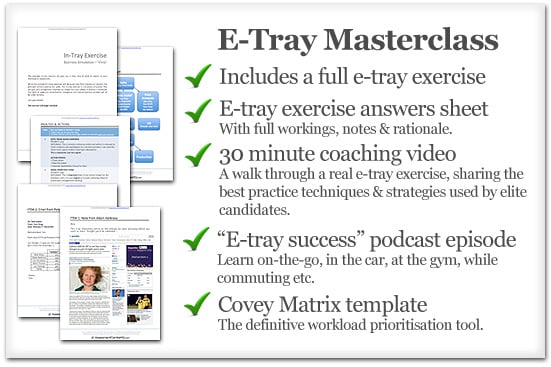
3 Simple Steps To E-tray Exercise Success
Ok, let’s get to the secret sauce and explain how to pass your e-tray exercise and earn a glowing review from the assessors.
Step 1 – Get In to the Right Mindset
Before you begin have this question foremost in mind: “What are the key things this employer wants from the person doing this role?” Keep this thought in mind throughout the exercise, it will ensure that your decisions and recommendations remain relevant to the overall aim.
PRO TIP: You can get total clarity on this by asking the company’s HR or personnel department to forward you a job description for the role beforehand. (This is perfectly fair and not only will this help you enormously in your preparation but it also demonstrates initiative and drive.) The job description will have a list of the core competencies required for the role. It’s basically a checklist of what the employer is looking for. Gold dust!
Step 2 – Scan and Prioritize
The first thing you need to do is to prioritise your workload. This will ensure that the most important and urgent tasks are given priority.
Grab some notepaper and a pen and draw the following matrix to create 4 boxes.
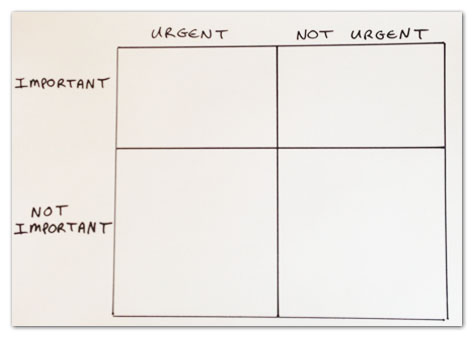
Now number each box like this:
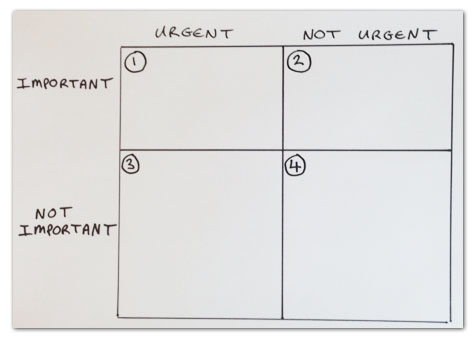
Now go through your imaginary workload and review each item. Remember, we’re not processing or resolving these issues right now, all we’re doing is prioritising each one.
For each item:
- Identify the issue/problem. Understand it. Consider its implications. Understand the motivation and drivers of the sender.
- Keep a close eye on the detail. (When is the item dated? Is there a deadline? Etc)
- Answer this question: ‘How important and urgent is this issue?’
Use the 4 boxes to assign a number to each item and ‘place’ it into the corresponding box, or just mark it electronically. Whatever method you use, it’s important to keep track in some way as you can quickly become overwhelmed.
Items that you place in box 1 must be both important and urgent.
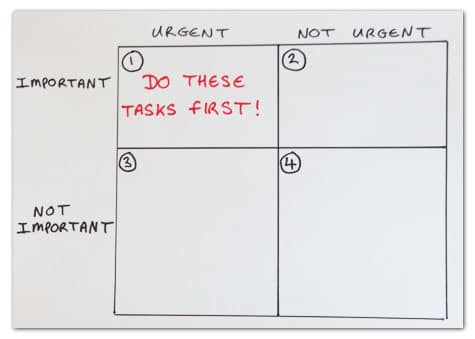
Items you place in box 2 are important but not urgent. These should be dealt with after you’ve resolved the contents of box 1.
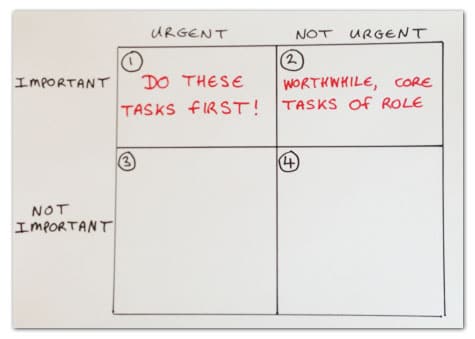
Items you place in box 3 are not important to your role, but they require an urgent response.
Often these items will be urgent to someone else (a colleague or another department). You should use your judgement as to which items to deal with here.
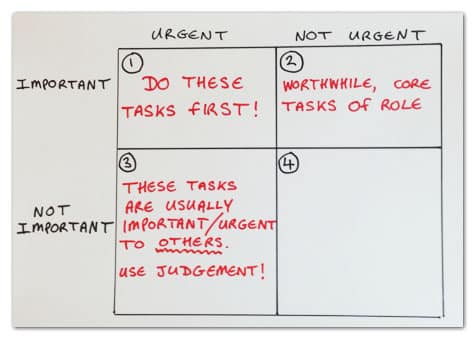
Items you place in box 4 are not important and not urgent. These are basically timewasters and should be your last priority. Consider not addressing them at all.
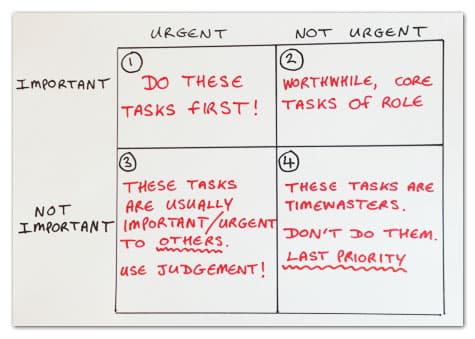
Ok so now we have a fully prioritised workload and it’s time to address each item in the following order:
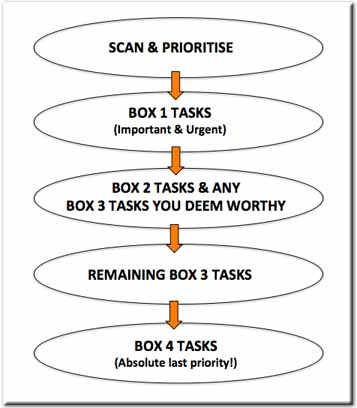
Step 3: Deal With Each Item
For each item that you placed in box 1 you need to provide:
- A list of actions which includes your analysis of each of the items.
- The priority that you would assign to each item. [We’ve already done this of coure.]
- Include who should be involved (colleague, department, 3rd party other stakeholder etc).
While doing this consider the following:
- In the real world, how would I deal with this?
- What can I do to resolve this issue, now or in the future?
- Should I delegate this or take ownership of it myself?
- What colleagues, or 3rd parties can help me resolve this?
- What colleagues, or 3rd parties need to be made aware of this?
- Do I need to flag this for follow up?
- Remember to write down all of your observations. Use sticky notes to annotate them as you go along. This is a big help when you have up to 30 documents to review and also demonstrates your thought process to the assessors.
PRO TIP: This is when you MUST have the job description for the role at the forefront of your mind. Keep asking yourself “what does this company want from someone performing this role?” as answering that question will ensure you deal appropriately with every item. BONUS PRO TIP!: Remember what’s being measured here – prioritisation skills, analytical skills, communication skills, written skills, delegation skills and business acumen. Keep these in mind as your address each item.
Follow the workflow through and repeat the above process for boxes 2,3 and 4.
Congratulations! You just critically analysed, prioritised and processed a large workload and demonstrated a host of valuable skills to your prospective employer.
Download Your E-Tray Masterclass Now

More E-tray/In-Tray Tests
You can get try more e-tray tests that are used by employers here and here. They’re not free, but they will show you exactly what to expect and are a must for people who want to do everything possible to increase their chances of success.
Nothing will improve your ability to perform strongly on the day more than practise. Practising improves your skill and confidence and also reduces stress and anxiety on the day. (Which makes it a no-brainer in our book.)
Podcast Episode
You can listen to out podcast on e-tray success, a companion to this guide, by clicking here.
Some Final Questions for You…
- Do you have to take a numerical reasoning test or a verbal reasoning test? If so you may want to check out the aptitude tests section of the site.
- You can find practice tests and tons of free advice on every other type of ‘reasoning test’ too: numerical, verbal, abstract, logical, inductive, diagrammatic, spatial, mechanical comprehension, UKCAT , Korn Ferry Assessment and Watson-Glaser tests.
- Worried about your assessment day? Maybe you’re worried about performing a presentation or preparing for an interview or group exercise or in-tray exercise?
- Perhaps you’d like some guidance on how to deal with nerves & anxiety at your interview?
- Lastly the Tools and Resources page is packed with useful equipment and ‘A’ List recommendations that will make your life easier.
Good Luck!
We hope you enjoyed this free guide? We’d love to hear your feedback so please do get in touch and let us know. Thanks and good luck with your e-tray exercise!
Turbocharge your employability NOW
Get your copy of our Ultimate Assessment Day & Interview Guide here. It's packed with tips, tricks and insider-secrets to help you succeed.
.
© Copyright AssessmentCentreHQ - All Rights Reserved
.



